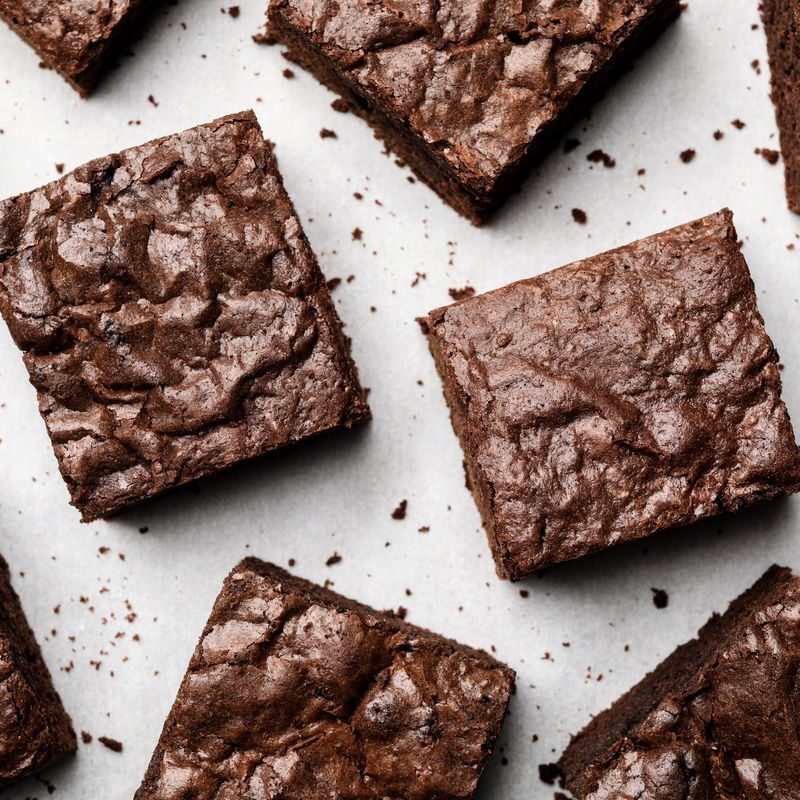
Brownies are a classic dessert loved by many people. They’re delicious, chewy, and have an intense, rich chocolate taste. The dense but fluffy chocolate bars are a nostalgic dessert for many and are very easy to bake. One thing that divides people, however, is whether they prefer their brownies to be more fudgy or cakey. So for our recipe, we decided to choose a recipe somewhere in between those two textures, and then alter it two different ways: one way to make it more cakey and one way to make it more fudgy. Using simple baking science and a few small adjustments, we plan to create two different types of brownies with two very different textures. We’re hoping our alterations to an already great recipe will satisfy all brownie lovers with all preferences.
The science behind this recipe: In this recipe, there is no leavening agent (baking soda or powder) because brownies do not need big air pockets or need to be light like a cake. This recipe also uses all-purpose flour because it does not have a high protein content. Flour with a higher protein content will produce a dense and chewier brownie. Mixing the oil and water together and then adding them to the flour mixture does not entirely prevent the water from interacting with the flour proteins and forming gluten, but it does ensure that the oil does coat some proteins in the flour and does prevent some gluten formation, which is why brownies aren’t super chewy like bread is. Additionally, this recipe uses eggs because it contains lecithin which is an emulsifier and is able to bind the water and oil together to create a cohesive homogenous mixture. The hydrophilic head bonds with the water and the hydrophobic tail bonds with the oil, binding them together. Within this recipe, two different types of sugar are used. Both sugars bring a lot of sweetness to the brownies and allow for a Maillard browning reaction, which in turn helps create the dark crust of the brownies. Specifically, powdered sugar dissolves easier than granulated because the crystals are smaller. The cocoa powder’s function in this recipe is to enhance the chocolate flavor and contribute to the brown color of the brownies. Since it is acidic, cocoa powder also helps limit a lot of gluten formation. The fat in this recipe, the oil, helps tenderize the batter because it is structure weakening, which also prevents too much gluten formation from occurring. There’s a lot of science going on in something as simple as a brownie recipe!
Click here for the alterations needed to create a fudgier brownie.
Click here for the alterations needed to create a cakier brownie.
About the authors of this post: Gracie Kummer and Natalia Donia
Ingredients
Instructions
- Preheat the oven to 325°F.
- Lightly spray an 8x8 baking dish with cooking spray and line it with parchment paper.
- In a medium bowl, combine the sugar, flour, cocoa powder, powdered sugar, chocolate chips, and salt.
- In a large bowl, whisk together the eggs, oil, water, and vanilla extract.
- Sprinkle the dry mix over the wet mix and stir until just combined.
- Pour the batter into the prepared pan and use a spatula to smooth the top. Bake for 40 to 48 minutes or until a toothpick comes out with only a few crumbs attached.
- Cool completely before slicing! Store in an airtight container at room temperature for up to 3 days.
Notes
“Best Homemade Brownies.” Love and Lemons, 27 Jan. 2023, https://www.loveandlemons.com/brownies-recipe/. Photo citation: Leite, David. “Care Package Brownies.” Leite's Culinaria, 27 Apr. 2023, https://leitesculinaria.com/70219/recipes-care-package-brownies.html.